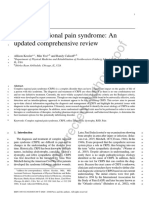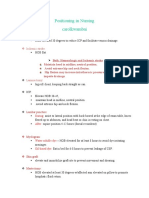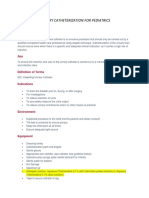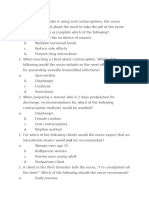0 ratings0% found this document useful (0 votes)
426 viewsPositioning
Positioning
Uploaded by
MabesThis document discusses proper positioning of clients to prevent complications and promote function. It describes various positions including supine, side-lying, and high Fowler's, indicating their uses and any contraindications. Proper positioning helps maintain muscle tone, skin integrity, and joint mobility. The document also covers safe transport between bed and wheelchair, assisting with ambulation to increase strength and mobility, and controlling orthostatic hypotension such as avoiding sudden changes in position.
Copyright:
© All Rights Reserved
Available Formats
Download as DOCX, PDF, TXT or read online from Scribd
Positioning
Positioning
Uploaded by
Mabes0 ratings0% found this document useful (0 votes)
426 views3 pagesThis document discusses proper positioning of clients to prevent complications and promote function. It describes various positions including supine, side-lying, and high Fowler's, indicating their uses and any contraindications. Proper positioning helps maintain muscle tone, skin integrity, and joint mobility. The document also covers safe transport between bed and wheelchair, assisting with ambulation to increase strength and mobility, and controlling orthostatic hypotension such as avoiding sudden changes in position.
Copyright
© © All Rights Reserved
Available Formats
DOCX, PDF, TXT or read online from Scribd
Share this document
Did you find this document useful?
Is this content inappropriate?
This document discusses proper positioning of clients to prevent complications and promote function. It describes various positions including supine, side-lying, and high Fowler's, indicating their uses and any contraindications. Proper positioning helps maintain muscle tone, skin integrity, and joint mobility. The document also covers safe transport between bed and wheelchair, assisting with ambulation to increase strength and mobility, and controlling orthostatic hypotension such as avoiding sudden changes in position.
Copyright:
© All Rights Reserved
Available Formats
Download as DOCX, PDF, TXT or read online from Scribd
Download as docx, pdf, or txt
0 ratings0% found this document useful (0 votes)
426 views3 pagesPositioning
Positioning
Uploaded by
MabesThis document discusses proper positioning of clients to prevent complications and promote function. It describes various positions including supine, side-lying, and high Fowler's, indicating their uses and any contraindications. Proper positioning helps maintain muscle tone, skin integrity, and joint mobility. The document also covers safe transport between bed and wheelchair, assisting with ambulation to increase strength and mobility, and controlling orthostatic hypotension such as avoiding sudden changes in position.
Copyright:
© All Rights Reserved
Available Formats
Download as DOCX, PDF, TXT or read online from Scribd
Download as docx, pdf, or txt
You are on page 1of 3
POSITIONING
Putting the client in an appropriate position to prevent development of complications and to
promote a function.
Change position frequently every 2 hours to prevent muscle discomfort, pressure ulcer, and
contractures. It can maintain muscle tone and stimulate postural reflexes.
Assess clients skin and provide skin care before and after positioning.
Use appropriate support devices or get assistance to co-workers if client cant move
independently and cannot be assisted with moving or turning.
Provide a firm mattress not sagging (contributes to low back pain and hip flexion contractures)
and bed and beddings should be dry, clean, and not wrinkled.
Position Description Indications Contraindications
Standing Anatomical position PA: best to assess for posture,
body alignment, and contours;
front, back, side parts of the body.
Rombergs Test
Leg problems
Back problems
Weak elderly
Hypotensive
Provide hand grip for
clients who cant stand.
Sitting Upright, sitting position
Promotes lung expansion
PA: Vital Signs, good visualization
of front and back upper body.
Thoracentesis
Physically weak
Orthopneic /
Tripod
Sitting in bed or on the side
of bed with arms leaning on
overbed table in front and
with pillow/s on top of table
to rest on.
Promotes maximum
chest expansion
Orthopnea (DOB except in upright
sitting position)
Supine Back-lying with or w/o
pillow on head and
shoulder, legs extended,
and feet dorsiflexed to
prevent foot drop; can
elevate forearm on pillow
placed on side.
Most relaxing position
PA: best for abdominal
assessment; V/S, easy access to
pulse sites, frontal body parts
Post lumbar puncture (NO
PILLOW) for 6 12 hours
Cardio and respiratory
problems
Dorsal
Recumbent
Back-lying with knees
flexed and feet flat on
surface
PA: perineal and rectal
IE of perineum
Perineal flushing and shaving
Peri-lighting after NSD
Catheterization
Cardiac and respiratory
problems
Prone Lying on the abdomen,
head turned to one side.
Hips are not flexed. Arms in
line with head.
Allows full extension of hip and
joints and prevents hip and
knee contractures
Unconscious client to prevent
aspiration.
Post surgery of mouth and
throat (Post tonsillectomy and
adenoidectomy)
Meningocele repair (birth defects
of spine and spinal membranes)
Post amputation (after the first
24 hours) for 20 minutes, several
times a day.
Poor body alignment
Lumbar spine
abnormalities
Cervical and neck
problems
Cardiac and respiratory
Causes plantar flexion
ONLY USED FOR
SHORT PERIODS OF
TIME
Side-lying /
Lateral
Lying on the side, partially
on the abdomen, flexing top
hip and knee, and placing
this leg in front of the body.
Reduces lordosis and promotes
good back alignment
Relieve pressure on sacrum
Lumbar puncture (spinal tap)
Limited joint movement
(hinders to bend hip
and knee)
Weak Elders
Support upper arm and leg
with pillows to prevent
adduction of shoulder and
hip.
After liver biopsy (right S lying)
Seizures (recovery position)
Supine Vena Cava Syndrome
(lateral recumbent)
Fetal heart rate deceleration
Sims or
Semi-prone
Lying on the side, semi
prone (lower arm behind
the body, uppermost leg
flexed at hip and knee,
upper arm flexed at
shoulder and elbow.
PA: rectum, vaginal
Rectal procedures & surgery
Rectal Enema (cleansing enema
b/c of the direction of colon)
Unconscious client to prevent
aspiration
Paralyzed clients (reduces
pressure on sacrum)
Comfortable for Pregnant
women
Obese
Weak Elders
Limited joint movement
Lithotomy Lying on the back with feet
supported on stirrups
Minimize time and keep
client well draped
PA: max exposure of vagina,
rectum
Perineal, vaginal, and rectal
procedures
Labor and Delivery, D&C
Catheterization
DOB
Leg problems
Weak Elders
Low Fowlers
or Semi-sitting
HOB elevated at 30
Allows chest expansion
and lung ventilation
Do not place overly large
pillow or pillows under the
neck which can lead to
neck flexion contractures
Dyspnea (DOB)
Normal Feeding
Increased ICP
Post-cataract surgery
Spinal problems
Cervical and neck
problems
Semi
Fowlers
HOB elevated at 45 Dyspnea (DOB)
Normal Feeding
Increased ICP
Autonomic Dysreflexia
Bleeding Esophageal Varices
Post - thyroidectomy
High Fowlers HOB elevated at 90 Dyspnea (DOB)
Normal Feeding
NGT Insertion and Feeding
Increased ICP
Autonomic Dysreflexia
Status Asthmaticus
Pneumothorax
Hiatal Hernia
GERD
Genupectoral /
Knee Chest
Trunk perpendicular to the
chest
WOF: do not leave client
alone. May feel dizzy,
faint, and fall.
N/A if Hypertensive
PA: rectum
Rectal Exam
Rectal (Fleet & Suppository)
Enema
Prostate Gland Exam
TX to bring uterus back to
normal position
DOB
Spinal, Cervical, and
neck problems
Leg problems
Weak Elders
Trendelenburg
Modified
Trendelenburg
Head down and legs
elevated
Lying on back & feet
elevated at 30 45* for
venous return
SHOCK
Circulatory Stasis
Hypotension
Clients who need increased
cerebral perfusion
Increased ICP & IOP
Cerebral Edema
Patient who will vomit
(increases pressure to
brain)
Reverse
Trendelenburg
Entire bed tilted with feet
downward
Prevents Gastric Reflux
Note:
Best position for a client to assume when moved up in bed is SUPINE with knees flexed (dorsal
recumbent)
Rectal Exam: Genupectural, Sims, and Horizontal Recumbent
Transport of Client
Always lock wheels on bed, stretcher, or wheelchair. Unexpected movements may result to injury
A. Bed to Wheelchair
Position wheelchair PARALLEL to bed.
Lock the wheels of the wheelchair and foot pedals up.
B. Bed to Stretcher
Place stretcher parallel to the bed.
Push the stretcher from the end where clients head is positioned.
Lock the wheels of the bed and stretcher.
When entering elevator, clients head goes in first.
Others:
* Use draw sheet when moving CVA clients up in bed.
* Highest priority of hemiplegic clients is SAFETY.
Assisting Clients in Ambulation
To increase muscle strength and joint mobility
To prevent potential problems of immobility
To increase sense of independence and self- esteem of client
Ambulate client gradually to prevent ORTHOSTATIC HYPOTENSION
If OHP or extreme weakness occurs, assist client quickly in a SITTING position and LOWER THE
HEAD between the knees to facilitate blood flow to brain.
If the client becomes dizzy or starts to fall during ambulation, slowly and gently lower him to the
floor and call for help. If the client is at high risk for falls, 2 nurses may be required to assist with
ambulation.
Controlling Orthostatic Hypotension
1. Avoid sudden position changes. Arise in bed in 3 stages
a. Sit up in bed for 1 minute
b. Sit on the side of bed, legs dangling for 1 minute
c. Stand holding to the edge of bed or another non-movable object for 1 minute
2. Wear elastic stockings at night to prevent venous pooling in legs
3. BEWARE of signs of OHP:
30 60 minutes after heavy meal.
1 2 hours after anti-hypertensive drugs
4. Get out of hot bath slowly. High temp can lead to venous pooling.
5. Refrain from strenuous activity which results to Vasalva Maneuver which DECREASES HEART
RATE leading to DECREASE BP.
You might also like
- Peds HESI Study GuideDocument5 pagesPeds HESI Study Guidemscostello985367% (9)
- Nclex TermsDocument48 pagesNclex TermsCristina Centurion100% (2)
- Nutrition and Diet Therapy Summary of BookDocument17 pagesNutrition and Diet Therapy Summary of BookMabes88% (8)
- Complex Regional Pain SyndromeDocument12 pagesComplex Regional Pain Syndromelazaro jara andradeNo ratings yet
- Positioning Patients Cheat SheetDocument7 pagesPositioning Patients Cheat SheetUchi Nurul Fauziah100% (1)
- SOAPIEDocument34 pagesSOAPIEEm Castillo100% (2)
- Assessment Worksheet AnswersDocument4 pagesAssessment Worksheet AnswersLouis UranoNo ratings yet
- Prof Ad BON and NursesDocument7 pagesProf Ad BON and NursesMabesNo ratings yet
- Positioning NCLEXDocument4 pagesPositioning NCLEXShazaNo ratings yet
- AtireviewDocument163 pagesAtireviewGlory Mimi0% (1)
- Bedbath & Perineal CareDocument22 pagesBedbath & Perineal Carealelicheng100% (1)
- Fundamentals of Nursing PracticeDocument9 pagesFundamentals of Nursing PracticejeshemaNo ratings yet
- Hot and Cold ApplicationDocument47 pagesHot and Cold ApplicationElaine Frances IlloNo ratings yet
- Bed-Occupied BedDocument3 pagesBed-Occupied Bedjerry thomas royNo ratings yet
- HandwashingDocument13 pagesHandwashingdjdk100% (2)
- Funda Rle Bed MakingDocument4 pagesFunda Rle Bed MakingIvan MaximusNo ratings yet
- Periop QuizesDocument9 pagesPeriop QuizesAnonymous ZQ4gHahzNo ratings yet
- Positioning in Nursing Carolkwambai: Hemorrhagic StrokeDocument5 pagesPositioning in Nursing Carolkwambai: Hemorrhagic StrokeCarol KenyaNo ratings yet
- Reviewer For The Board ExamDocument40 pagesReviewer For The Board ExamCharina Aubrey RiodilNo ratings yet
- Neurological AssessmentDocument61 pagesNeurological AssessmentSamantha SunglaoNo ratings yet
- Priority Nursing Actions Allen's TestDocument6 pagesPriority Nursing Actions Allen's Testwanda100% (2)
- Postpartum NCLEXDocument2 pagesPostpartum NCLEXJabber PaudacNo ratings yet
- GoodDocument21 pagesGoodVanessaMUeller80% (5)
- NCM Checklist - Occupied and Unoccupied BedDocument6 pagesNCM Checklist - Occupied and Unoccupied BedYanna Habib-MangotaraNo ratings yet
- Urinary Catheterization For PediatricsDocument6 pagesUrinary Catheterization For PediatricsMichael Montinola100% (1)
- Urinary Catheter InsertionDocument4 pagesUrinary Catheter InsertionAngel SamonteNo ratings yet
- Nursing Practice IVDocument16 pagesNursing Practice IVJohn wewNo ratings yet
- Tracheostomy Suctioning SkillDocument6 pagesTracheostomy Suctioning Skill3thanKimNo ratings yet
- Gravidity and ParityDocument11 pagesGravidity and ParityShahad HakimuddinNo ratings yet
- Enema-Check-List RationaleDocument5 pagesEnema-Check-List Rationaleamal abdulrahmanNo ratings yet
- University of The EastDocument33 pagesUniversity of The EastSEAN MELNOR LOSBAÑESNo ratings yet
- Administering Enema POWERPOINT GIVING ENEMA TO PATIENT, FOR PATIENT WITH GASTROINTESTINAL DISORDERS .. LECTURES, PRINCIPLES AND PROCEDURESDocument14 pagesAdministering Enema POWERPOINT GIVING ENEMA TO PATIENT, FOR PATIENT WITH GASTROINTESTINAL DISORDERS .. LECTURES, PRINCIPLES AND PROCEDURESPb0% (1)
- Nursing Bullets: Fundamentals of Nursing ReviewerDocument44 pagesNursing Bullets: Fundamentals of Nursing ReviewerErl DiamanteNo ratings yet
- Fundamentals of NursingDocument25 pagesFundamentals of NursingrihamNo ratings yet
- How To Do Tepid Sponge Bath: InstructionsDocument2 pagesHow To Do Tepid Sponge Bath: Instructionssuandi isindaNo ratings yet
- Universidad de Zamboanga Tiguma, Pagadian City Competency Appraisal II Pre Final ExamDocument5 pagesUniversidad de Zamboanga Tiguma, Pagadian City Competency Appraisal II Pre Final ExamKirsten SabanalNo ratings yet
- 4 Urinary and Bowel EliminationDocument59 pages4 Urinary and Bowel Eliminationsechzhen100% (1)
- Explain The Principles Invloved in Perineal Care and Perilite ExposureDocument5 pagesExplain The Principles Invloved in Perineal Care and Perilite ExposureCarmel Marie VenezuelaNo ratings yet
- Predictor 6Document42 pagesPredictor 6Christine Ann GuinitaranNo ratings yet
- Fundamental Hesi Review NotesDocument2 pagesFundamental Hesi Review NotesMike Burgess50% (2)
- Bed Bath & Bed ShampooDocument42 pagesBed Bath & Bed ShampooRusjen Claire Villamero100% (1)
- Transfer TechniquesDocument5 pagesTransfer TechniquesJan Jamison Zulueta100% (1)
- 350 Nursing Bullets MaternalDocument18 pages350 Nursing Bullets MaternalJulian ParadaNo ratings yet
- Nursing Skill Iv InsertionDocument8 pagesNursing Skill Iv InsertionSabrina TolentinoNo ratings yet
- MCN PretestDocument16 pagesMCN PretestrikidbNo ratings yet
- Bowel and Bladder EliminationDocument9 pagesBowel and Bladder EliminationApril Urbano-Gabot Alap0% (1)
- Oropharyngeal and Nasopharyngeal SuctioningDocument2 pagesOropharyngeal and Nasopharyngeal SuctioningAlana Caballero100% (1)
- Wound Care ChecklistDocument2 pagesWound Care ChecklistJay Lemuel BuenviajeNo ratings yet
- Nursing Board Exam Test Taking StrategiesDocument39 pagesNursing Board Exam Test Taking StrategiesHenry ApolNo ratings yet
- Case Study On Communicable DiseaseDocument15 pagesCase Study On Communicable DiseaseThiradevi BalakrisnanNo ratings yet
- Positioning and Moving Clients in BedDocument31 pagesPositioning and Moving Clients in BedFrancis Lee Pintac LocsinNo ratings yet
- Catheter ChecklistDocument2 pagesCatheter ChecklistArky VessaliuzNo ratings yet
- Abdominal AssessmentDocument2 pagesAbdominal AssessmentJan Jamison ZuluetaNo ratings yet
- Perioperative Nursing Med-SurgDocument3 pagesPerioperative Nursing Med-SurgKarla Fralala100% (1)
- November 2008Document62 pagesNovember 2008Ruth BadillaNo ratings yet
- Serving and Removing of Bedpan and Urinal EditedDocument30 pagesServing and Removing of Bedpan and Urinal Editedshannon c. lewisNo ratings yet
- CystocylsisDocument7 pagesCystocylsisJennifer DimapilisNo ratings yet
- 000maternal and Child Health Practice Test Part 2-QuestionDocument13 pages000maternal and Child Health Practice Test Part 2-QuestionAngie MandeoyaNo ratings yet
- Pre TestDocument5 pagesPre TestZhyraine Iraj D. CaluzaNo ratings yet
- Moving A Client Up in Bed Procedure ChecklistDocument3 pagesMoving A Client Up in Bed Procedure ChecklistDarwin Sang-anNo ratings yet
- Ventricular Septal Defect, A Simple Guide To The Condition, Treatment And Related ConditionsFrom EverandVentricular Septal Defect, A Simple Guide To The Condition, Treatment And Related ConditionsNo ratings yet
- Chicago Review Press NCLEX-PN Practice Test and ReviewFrom EverandChicago Review Press NCLEX-PN Practice Test and ReviewRating: 4 out of 5 stars4/5 (4)
- Study Guide For NCLEX PNDocument146 pagesStudy Guide For NCLEX PNkjtwjyvm2hNo ratings yet
- Bowel Diversion: Parameter Colostomy IleostomyDocument1 pageBowel Diversion: Parameter Colostomy IleostomyMabesNo ratings yet
- PainDocument3 pagesPainMabesNo ratings yet
- CHN GapuzDocument23 pagesCHN GapuzMabes100% (1)
- Triage PrinciplesDocument2 pagesTriage PrinciplesMabesNo ratings yet
- Therapeutic Diet NutritionistDocument3 pagesTherapeutic Diet NutritionistMabesNo ratings yet
- Commonly Asked Emergency DrugsDocument17 pagesCommonly Asked Emergency DrugsrianneNo ratings yet
- Asepsis and InfectionDocument6 pagesAsepsis and InfectionMabes100% (1)
- Mabes Fluid and Electrolyte ImbalancesDocument15 pagesMabes Fluid and Electrolyte ImbalancesMabesNo ratings yet
- Parenteral Therapy:: Intravenous Therapy (IVT) or VenipunctureDocument3 pagesParenteral Therapy:: Intravenous Therapy (IVT) or VenipunctureMabes100% (1)
- Enema Administration: Size of Rectal TubeDocument3 pagesEnema Administration: Size of Rectal TubeMabesNo ratings yet
- All Nursing TheoriesDocument26 pagesAll Nursing TheoriesMabesNo ratings yet
- Blood Transfusion Purpose: 9. Check Blood For Presence of BubblesDocument2 pagesBlood Transfusion Purpose: 9. Check Blood For Presence of BubblesMabes100% (1)
- Nervous SystemDocument11 pagesNervous SystemMabes100% (1)
- Roses Are Red, Violets Are Blue, Without Your Lungs Your Blood Would Be, Too.Document249 pagesRoses Are Red, Violets Are Blue, Without Your Lungs Your Blood Would Be, Too.MabesNo ratings yet
- Basic or InstrumentsDocument21 pagesBasic or InstrumentsMabes100% (1)
- DocumentationDocument3 pagesDocumentationMabesNo ratings yet
- Decubitus Ulcer / Pressure SoresDocument1 pageDecubitus Ulcer / Pressure SoresMabesNo ratings yet
- Taste and SmellDocument1 pageTaste and SmellMabesNo ratings yet
- Basic Therapeutic DietsDocument3 pagesBasic Therapeutic DietsMabes100% (1)
- Suture and NeedlesDocument5 pagesSuture and NeedlesMabesNo ratings yet
- Water Soluble VitaminsDocument6 pagesWater Soluble VitaminsMabesNo ratings yet
- Fat Soluble VitaminsDocument5 pagesFat Soluble VitaminsMabesNo ratings yet
- The Concepts of Man and His Basic NeedsDocument5 pagesThe Concepts of Man and His Basic NeedsMabes94% (18)
- Nutritional Recommendation For Cardiovascular DiseaseDocument5 pagesNutritional Recommendation For Cardiovascular DiseaseMabesNo ratings yet
- Introduction To Nursing TheoriesDocument7 pagesIntroduction To Nursing TheoriesMabes100% (2)
- Factors That Affect Eating and NurtritureDocument3 pagesFactors That Affect Eating and NurtritureMabesNo ratings yet
- Open HemorrhoidectomyDocument4 pagesOpen HemorrhoidectomyCaesar Rio Julyanto Putra0% (1)
- Down SyndromeDocument48 pagesDown SyndromeJohn Paul Parungao CrisostomoNo ratings yet
- Ch. 38 - Peripheral Vascular Disease NCLEX QuestionsDocument7 pagesCh. 38 - Peripheral Vascular Disease NCLEX QuestionsBenjamin EspinosaNo ratings yet
- AUBF QFRs Week 2Document8 pagesAUBF QFRs Week 2Jacquelyn PerezNo ratings yet
- A-600-9017 - Principles of Exercise Fitness and Health - Mock PaperDocument4 pagesA-600-9017 - Principles of Exercise Fitness and Health - Mock PaperLeonSylvesterNo ratings yet
- Attachment ReportDocument5 pagesAttachment ReportBoas Wayne25% (4)
- Paranoid SchizophreniaDocument12 pagesParanoid Schizophreniakiran mahalNo ratings yet
- Urticaria (Hives) : DrugsDocument15 pagesUrticaria (Hives) : DrugsSartika Akib100% (1)
- Diabetc Keto AcidosisDocument13 pagesDiabetc Keto AcidosisVijiNo ratings yet
- Acute Respiratory InfectionsDocument4 pagesAcute Respiratory InfectionsLorena Hernandez EscobedoNo ratings yet
- AdenotonsillectomyDocument27 pagesAdenotonsillectomymagdalenaNo ratings yet
- Health Care Delivery System in India Seminar Nursing EducationDocument24 pagesHealth Care Delivery System in India Seminar Nursing EducationSopan ShindeNo ratings yet
- YÖKDİL Sağlık Bilimleri Cümle Tamamlama SorularıDocument10 pagesYÖKDİL Sağlık Bilimleri Cümle Tamamlama SorularıAhmed HannanNo ratings yet
- 2021 NA Products and Sales Compliance (Conventional) - Critical Care PlansDocument206 pages2021 NA Products and Sales Compliance (Conventional) - Critical Care PlansZX LeeNo ratings yet
- RybelsusDocument9 pagesRybelsusPatricia Karina Ríos NevarezNo ratings yet
- Tia Tele PlatformDocument5 pagesTia Tele PlatformAshwaq TpNo ratings yet
- West Visayas State University: Unified Research Ethics Review CommitteeDocument2 pagesWest Visayas State University: Unified Research Ethics Review CommitteeLianne Grace ParreñasNo ratings yet
- Drug Study - Nalbuphine (Nubain)Document3 pagesDrug Study - Nalbuphine (Nubain)Maria Theresa BuscasNo ratings yet
- Stasis Dermatitis and Leg UlcersDocument76 pagesStasis Dermatitis and Leg Ulcersozhan_holmesNo ratings yet
- Fs Pandemic Preparedness and Response PlanDocument22 pagesFs Pandemic Preparedness and Response PlanAlexis AlbosNo ratings yet
- BP404 Pharmacology - I Assignment-1Document1 pageBP404 Pharmacology - I Assignment-1Radhika JasaniNo ratings yet
- The Psychodynamic Diagnostic ManualDocument6 pagesThe Psychodynamic Diagnostic ManuallukasNo ratings yet
- Microbiology BSMMU QuestionDocument24 pagesMicrobiology BSMMU QuestionMustajib Haider RajonNo ratings yet
- Scribd Marketing Plan For Oak PharmacyDocument13 pagesScribd Marketing Plan For Oak PharmacyfunmiaNo ratings yet
- PFT Form 1Document3 pagesPFT Form 1Jaypee SangilNo ratings yet
- Phi-Fpx 3200 - Ethics in Health Care-Assessment-1.Document5 pagesPhi-Fpx 3200 - Ethics in Health Care-Assessment-1.GaspariNo ratings yet
- New Patient PaperworkDocument3 pagesNew Patient PaperworkThomas CampbellNo ratings yet
- Thesis Statement Against Physician Assisted SuicideDocument8 pagesThesis Statement Against Physician Assisted Suicideallisonweavereugene100% (2)
- Inflammatory Response PathophysiologyDocument34 pagesInflammatory Response PathophysiologyBernardo Mucha100% (1)





















































































































